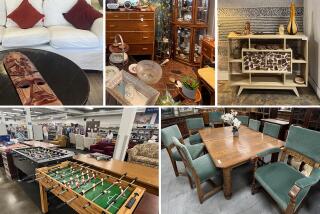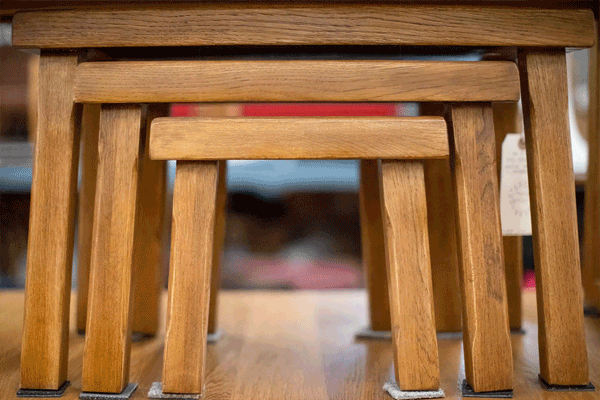For Home Design Deals, Try Consignment Shops
- Share via
Interior designers do it. Owners of stylish stores and restaurants do it. And so do thousands of savvy consumers, though some are reluctant to say so: They buy and sell furniture and home accessories at consignment shops.
Bored with that chintz chair? Looking for a landscape to hang over the mantel? Yearning for a set of silver serving pieces?
Think consignment shops, where sellers unload things they want to get rid of, often for more than they’d get at estate or yard sales; and buyers find things they want to acquire, usually for less than they’d pay at retail or antiques stores. The shop, in the middle, provides a venue, expertise and sales staff, and takes a commission of up to 50%.
“Consignment shopping is much more mainstream now,” says William West Hopper, who wrote his original “A Guide to Washington’s Thrift and Consignment Shops” in 1993 and updated it for 1998-99.
“People are realizing when they redecorate, instead of sending things they don’t want to their kids or to Goodwill, they can make $100 or $200 consigning furniture and then use the money to do something like buy more expensive fabrics for draperies,” says Hopper, who now runs estate sales.
*
What exactly is out there in consignment land? Furniture, from dining-room sets to night stands, bar stools to sofas. Fine china and everyday dishes. Sterling and silver-plate flatware, stemware, barware, platters, pitchers, vases, bowls and candelabra. Crystal goblets, tumblers and candlesticks. Venetian, Depression and cut glass. Table and bed linens. Artwork. Carpets.
Some shops lack room for large pieces of furniture or room-size rugs but will accept smaller pieces. Others deal only in decorative items. Many establishments offering home furnishings also sell jewelry, clothing and books.
So where might these great finds be found? Stylish and higher-end places draw customers with alluring displays: an antique table set with china, silver and linens; glass cases filled with crystal; attractive windows, good light, a scattering of non-consignment painted flowerpots, candles and pretty soaps that stoke the urge to splurge.
At the other end of the merchandising spectrum is the junkatorium, which might require a miner’s headlamp and respirator to penetrate the darkness and dust. But the eternally hopeful soldier on, convinced they’ll find riches amid the rubble, like the woman who recently snapped up a child-size Victorian-style ice cream table and chairs at the gloriously cluttered Annapolis Antiques & Consignment Shop.
*
So who sells? People who inherit furnishings they don’t want or need, who move into smaller digs, who are drowning in their own stuff or have to get rid of the old to make room for the new. Designers offloading rejected pieces, model-home builders closing up shop, manufacturers dumping overstock, even bankrupt businesses.
And who buys? Lots of famous--and discreet--people. Diva Barbra Streisand has amassed and sold fabulous collections of Art Deco and Stickley furniture.
Some decorators scouting for themselves or for clients haunt consignment shops, although staffers won’t name names.
How does consigning work? Unlike thrift stores, consignment shops impose higher standards.
Chipped or cracked items probably won’t be accepted unless they are part of a set. Some establishments insist that sterling, silver plate, brass and copper arrive polished. And while a bit of wear on rugs and furniture is tolerated, large stains and tears generally are not, unless an item has a fine pedigree or is priced low. Some stores have things they won’t take, ranging from weapons to water beds, appliances to exercise equipment.
If a shop agrees to take an item, a contract is signed that covers the basics: how much it will sell for; how much the seller will receive (between 50% and 80% of the price); how long merchandise will stay in the store (usually 60 to 180 days); the size and scheduling of markdowns; and the deadline for the consignor to remove things before the shop dumps them, gives them to charity or owns them outright. Items usually are sold as is, without warranties, returns or take-home trials.
More to Read
Sign up for The Wild
We’ll help you find the best places to hike, bike and run, as well as the perfect silent spots for meditation and yoga.
You may occasionally receive promotional content from the Los Angeles Times.






